# 梯度下降
> 原文:[https://www.bookbookmark.ds100.org/ch/11/gradient_descence_define.html](https://www.bookbookmark.ds100.org/ch/11/gradient_descence_define.html)
```
# HIDDEN
# Clear previously defined variables
%reset -f
# Set directory for data loading to work properly
import os
os.chdir(os.path.expanduser('~/notebooks/11'))
```
```
# HIDDEN
import warnings
# Ignore numpy dtype warnings. These warnings are caused by an interaction
# between numpy and Cython and can be safely ignored.
# Reference: https://stackoverflow.com/a/40846742
warnings.filterwarnings("ignore", message="numpy.dtype size changed")
warnings.filterwarnings("ignore", message="numpy.ufunc size changed")
import numpy as np
import matplotlib.pyplot as plt
import pandas as pd
import seaborn as sns
%matplotlib inline
import ipywidgets as widgets
from ipywidgets import interact, interactive, fixed, interact_manual
import nbinteract as nbi
sns.set()
sns.set_context('talk')
np.set_printoptions(threshold=20, precision=2, suppress=True)
pd.options.display.max_rows = 7
pd.options.display.max_columns = 8
pd.set_option('precision', 2)
# This option stops scientific notation for pandas
# pd.set_option('display.float_format', '{:.2f}'.format)
```
```
# HIDDEN
tips = sns.load_dataset('tips')
tips['pcttip'] = tips['tip'] / tips['total_bill'] * 100
```
```
# HIDDEN
def mse(theta, y_vals):
return np.mean((y_vals - theta) ** 2)
def grad_mse(theta, y_vals):
return -2 * np.mean(y_vals - theta)
def plot_loss(y_vals, xlim, loss_fn):
thetas = np.arange(xlim[0], xlim[1] + 0.01, 0.05)
losses = [loss_fn(theta, y_vals) for theta in thetas]
plt.figure(figsize=(5, 3))
plt.plot(thetas, losses, zorder=1)
plt.xlim(*xlim)
plt.title(loss_fn.__name__)
plt.xlabel(r'$ \theta $')
plt.ylabel('Loss')
def plot_theta_on_loss(y_vals, theta, loss_fn, **kwargs):
loss = loss_fn(theta, y_vals)
default_args = dict(label=r'$ \theta $', zorder=2,
s=200, c=sns.xkcd_rgb['green'])
plt.scatter([theta], [loss], **{**default_args, **kwargs})
def plot_tangent_on_loss(y_vals, theta, loss_fn, eps=1e-6):
slope = ((loss_fn(theta + eps, y_vals) - loss_fn(theta - eps, y_vals))
/ (2 * eps))
xs = np.arange(theta - 1, theta + 1, 0.05)
ys = loss_fn(theta, y_vals) + slope * (xs - theta)
plt.plot(xs, ys, zorder=3, c=sns.xkcd_rgb['green'], linestyle='--')
```
我們有興趣創建一個函數,它可以最小化損失函數,而不必強制用戶預先確定要嘗試的值是\theta$。換句話說,雖然`simple_minimize`函數具有以下簽名:
```
simple_minimize(loss_fn, dataset, thetas)
```
我們想要一個具有以下簽名的函數:
```
minimize(loss_fn, dataset)
```
此函數需要自動查找最小化的$\theta$值,無論其大小。我們將使用一種稱為梯度下降的技術來實現這個新的`minimize`函數。
### 直覺
與損失函數一樣,我們將首先討論梯度下降的直覺,然后用數學形式化我們的理解。
由于`minimize`函數沒有給定要嘗試的$\theta$的值,因此我們從選擇需要的任何位置的$\theta$開始。然后,我們可以迭代地改進對$\theta$的估計。為了改進對$\theta$的估計,我們研究了在選擇$\theta$時損失函數的斜率。
例如,假設我們對簡單數據集$\textbf y=[12.1、12.8、14.9、16.3、17.2]$使用 mse,而當前選擇的$\theta$是 12。
```
# HIDDEN
pts = np.array([12.1, 12.8, 14.9, 16.3, 17.2])
plot_loss(pts, (11, 18), mse)
plot_theta_on_loss(pts, 12, mse)
```
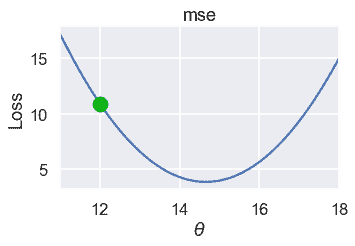
我們想為.\theta$選擇一個減少損失的新值。要做到這一點,我們看損失函數在$\theta=12$時的斜率:
```
# HIDDEN
pts = np.array([12.1, 12.8, 14.9, 16.3, 17.2])
plot_loss(pts, (11, 18), mse)
plot_tangent_on_loss(pts, 12, mse)
```
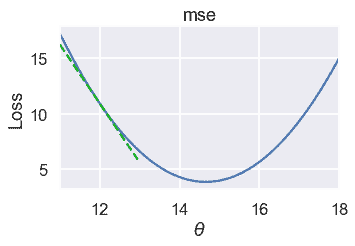
坡度為負,這意味著增加$\theta$將減少損失。
另一方面,如果$\theta=16.5 美元,則損失函數的斜率為正:
```
# HIDDEN
pts = np.array([12.1, 12.8, 14.9, 16.3, 17.2])
plot_loss(pts, (11, 18), mse)
plot_tangent_on_loss(pts, 16.5, mse)
```
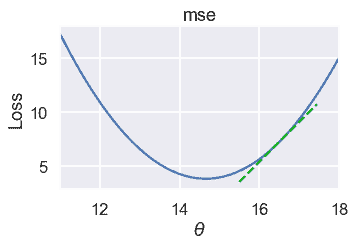
當坡度為正時,降低$\theta$將減少損失。
切線的斜率告訴我們移動$\theta$的方向,以減少損失。如果坡度為負,我們希望$\theta$朝正方向移動。如果坡度為正,則$\theta$應朝負方向移動。在數學上,我們寫道:
$$\theta^(t+1)=\theta^(t)-\frac \部分\部分\theta l(\theta ^(t),\textbf y)$$
其中,$\theta^(t)$是當前估計數,$\theta^(t+1)$是下一個估計數。
對于 MSE,我們有:
$$ \begin{aligned} L(\theta, \textbf{y}) &= \frac{1}{n} \sum_{i = 1}^{n}(y_i - \theta)^2\\ \frac{\partial}{\partial \hat{\theta}} L(\theta, \textbf{y}) &= \frac{1}{n} \sum_{i = 1}^{n} -2(y_i - \theta) \\ &= -\frac{2}{n} \sum_{i = 1}^{n} (y_i - \theta) \\ \end{aligned} $$
當$\theta^(t)=12$時,我們可以計算$-\frac 2 n sum i=1 n(y i-\theta)=-5.32$。因此,$\theta^(t+1)=12-(-5.32)=17.32 美元。
我們將舊的$theta$值繪制為綠色輪廓圓圈,新的值繪制為下面損失曲線上的填充圓圈。
```
# HIDDEN
pts = np.array([12.1, 12.8, 14.9, 16.3, 17.2])
plot_loss(pts, (11, 18), mse)
plot_theta_on_loss(pts, 12, mse, c='none',
edgecolor=sns.xkcd_rgb['green'], linewidth=2)
plot_theta_on_loss(pts, 17.32, mse)
```
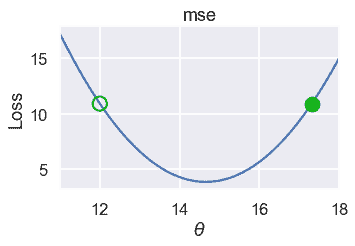
雖然$\theta$朝著正確的方向發展,但最終卻遠遠超出了最低值。我們可以通過將斜率乘以一個小常數,然后從$\theta$中減去它來解決這個問題。我們的最終更新公式是:
$$\theta^(t+1)=\theta^(t)-\alpha\cdot\frac \部分\部分\theta l(\theta ^(t),\textbf y)$$
其中,$\alpha$是一個小常量。例如,如果我們設置$\alpha=0.3$,這是新的$\theta^(t+1)$:
```
# HIDDEN
def plot_one_gd_iter(y_vals, theta, loss_fn, grad_loss, alpha=0.3):
new_theta = theta - alpha * grad_loss(theta, y_vals)
plot_loss(pts, (11, 18), loss_fn)
plot_theta_on_loss(pts, theta, loss_fn, c='none',
edgecolor=sns.xkcd_rgb['green'], linewidth=2)
plot_theta_on_loss(pts, new_theta, loss_fn)
print(f'old theta: {theta}')
print(f'new theta: {new_theta}')
```
```
# HIDDEN
plot_one_gd_iter(pts, 12, mse, grad_mse)
```
```
old theta: 12
new theta: 13.596
```
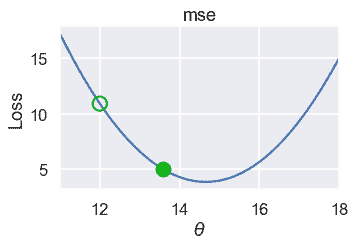
以下是此過程連續迭代的$\theta$值。請注意,$\theta$隨著接近最小損失而變化得更慢,因為坡度也更小。
```
# HIDDEN
plot_one_gd_iter(pts, 13.60, mse, grad_mse)
```
```
old theta: 13.6
new theta: 14.236
```
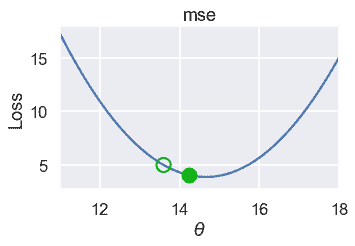
```
# HIDDEN
plot_one_gd_iter(pts, 14.24, mse, grad_mse)
```
```
old theta: 14.24
new theta: 14.492
```
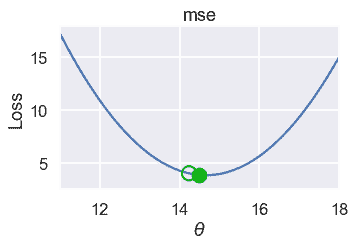
```
# HIDDEN
plot_one_gd_iter(pts, 14.49, mse, grad_mse)
```
```
old theta: 14.49
new theta: 14.592
```
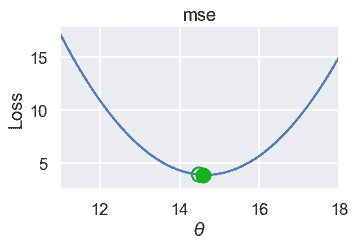
### 梯度下降分析
現在我們有了完整的梯度下降算法:
1. 選擇一個起始值$\theta$(0 是一個常見的選擇)。
2. 計算$\theta-\alpha\cdot\frac \partial \partial\theta l(\theta、\textbf y)$并將其存儲為新值$\theta$。
3. 重復直到$\theta$在迭代之間不改變。
您將更常見地看到梯度$\nabla_uta$代替部分導數$\frac \部分\部分\theta$。這兩個符號本質上是等效的,但是由于梯度符號更為常見,從現在起我們將在梯度更新公式中使用它:
$$\theta^(t+1)=\theta^(t)-\alpha\cdot\nabla\theta l(\theta^(t),\textbf y)$$
要查看符號:
* $\theta^(t)$是第$t$次迭代時的當前估計值$\theta^*。
* $\theta^(t+1)$是$\theta$的下一個選擇。
* $\alpha$稱為學習率,通常設置為一個小常量。有時,從一個更大的$\alpha$開始并隨著時間的推移減少它是有用的。如果在迭代之間$\alpha$發生變化,我們使用變量$\alpha^t$來標記$\alpha$隨時間變化$t$。
* $\nabla_ \theta l(\theta^(t),\textbf y)$是損失函數相對于時間$t$的偏導數/梯度。
現在您可以看到選擇一個可微分損失函數的重要性:$\nabla_theta l(\theta、\textbf y)$是梯度下降算法的關鍵部分。(雖然可以通過計算兩個稍有不同的$theta$值的損失差異并除以$theta$值之間的距離來估計梯度,但這通常會顯著增加梯度下降的運行時間,因此使用它變得不切實際。)
梯度算法簡單而強大,因為我們可以將它用于許多類型的模型和許多類型的損失函數。它是擬合許多重要模型的計算工具,包括大數據集和神經網絡上的線性回歸。
### 定義`minimize`函數[?](#Defining-the-minimize-Function)
現在,我們回到原來的任務:定義`minimize`函數。我們將不得不稍微改變我們的函數簽名,因為我們現在需要計算損失函數的梯度。
```
def minimize(loss_fn, grad_loss_fn, dataset, alpha=0.2, progress=True):
'''
Uses gradient descent to minimize loss_fn. Returns the minimizing value of
theta_hat once theta_hat changes less than 0.001 between iterations.
'''
theta = 0
while True:
if progress:
print(f'theta: {theta:.2f} | loss: {loss_fn(theta, dataset):.2f}')
gradient = grad_loss_fn(theta, dataset)
new_theta = theta - alpha * gradient
if abs(new_theta - theta) < 0.001:
return new_theta
theta = new_theta
```
然后我們可以定義函數來計算 mse 及其梯度:
```
def mse(theta, y_vals):
return np.mean((y_vals - theta) ** 2)
def grad_mse(theta, y_vals):
return -2 * np.mean(y_vals - theta)
```
最后,我們可以使用`minimize`函數計算$\textbf y=[12.1,12.8,14.9,16.3,17.2]$的最小化值。
```
%%time
theta = minimize(mse, grad_mse, np.array([12.1, 12.8, 14.9, 16.3, 17.2]))
print(f'Minimizing theta: {theta}')
print()
```
```
theta: 0.00 | loss: 218.76
theta: 5.86 | loss: 81.21
theta: 9.38 | loss: 31.70
theta: 11.49 | loss: 13.87
theta: 12.76 | loss: 7.45
theta: 13.52 | loss: 5.14
theta: 13.98 | loss: 4.31
theta: 14.25 | loss: 4.01
theta: 14.41 | loss: 3.90
theta: 14.51 | loss: 3.86
theta: 14.57 | loss: 3.85
theta: 14.61 | loss: 3.85
theta: 14.63 | loss: 3.84
theta: 14.64 | loss: 3.84
theta: 14.65 | loss: 3.84
theta: 14.65 | loss: 3.84
theta: 14.66 | loss: 3.84
theta: 14.66 | loss: 3.84
Minimizing theta: 14.658511131035242
CPU times: user 7.88 ms, sys: 3.58 ms, total: 11.5 ms
Wall time: 8.54 ms
```
我們可以看到,梯度下降很快找到了與解析法相同的解:
```
np.mean([12.1, 12.8, 14.9, 16.3, 17.2])
```
```
14.66
```
### 最小化 Huber 損失
現在,我們可以應用梯度下降來最小化提示百分比數據集上的 Huber 損失。
Huber 損失為:
L 123; 123; 1 2 \ delta)&;\text 否則\結束案例$$
Huber 損失的梯度為:
$$\nabla_\theta l_\delta(\theta,\textbf y)=\frac 1 n \sum i=1 n\ begin cases-(y \theta)&;y i-\theta \le\delta\
```
- \delta \cdot \text{sign} (y_i - \theta) & \text{otherwise}
```
\結束案例$$
(注意,在之前的 Huber 損失定義中,我們使用變量$\alpha$來表示轉換點。為了避免與梯度下降中使用的$\alpha$混淆,我們將 Huber 損失的過渡點參數替換為$\delta$。)
```
def huber_loss(theta, dataset, delta = 1):
d = np.abs(theta - dataset)
return np.mean(
np.where(d <= delta,
(theta - dataset)**2 / 2.0,
delta * (d - delta / 2.0))
)
def grad_huber_loss(theta, dataset, delta = 1):
d = np.abs(theta - dataset)
return np.mean(
np.where(d <= delta,
-(dataset - theta),
-delta * np.sign(dataset - theta))
)
```
讓我們最小化 Tips 數據集上的 Huber 損失:
```
%%time
theta = minimize(huber_loss, grad_huber_loss, tips['pcttip'], progress=False)
print(f'Minimizing theta: {theta}')
print()
```
```
Minimizing theta: 15.506849531471964
CPU times: user 194 ms, sys: 4.13 ms, total: 198 ms
Wall time: 208 ms
```
### 摘要[?](#Summary)
梯度下降給了我們一種一般的方法來最小化損失函數,當我們無法通過分析來求解$\theta$的最小值時。隨著我們的模型和損失函數的復雜性增加,我們將轉向梯度下降作為我們選擇適合模型的工具。
- 一、數據科學的生命周期
- 二、數據生成
- 三、處理表格數據
- 四、數據清理
- 五、探索性數據分析
- 六、數據可視化
- Web 技術
- 超文本傳輸協議
- 處理文本
- python 字符串方法
- 正則表達式
- regex 和 python
- 關系數據庫和 SQL
- 關系模型
- SQL
- SQL 連接
- 建模與估計
- 模型
- 損失函數
- 絕對損失和 Huber 損失
- 梯度下降與數值優化
- 使用程序最小化損失
- 梯度下降
- 凸性
- 隨機梯度下降法
- 概率與泛化
- 隨機變量
- 期望和方差
- 風險
- 線性模型
- 預測小費金額
- 用梯度下降擬合線性模型
- 多元線性回歸
- 最小二乘-幾何透視
- 線性回歸案例研究
- 特征工程
- 沃爾瑪數據集
- 預測冰淇淋評級
- 偏方差權衡
- 風險和損失最小化
- 模型偏差和方差
- 交叉驗證
- 正規化
- 正則化直覺
- L2 正則化:嶺回歸
- L1 正則化:LASSO 回歸
- 分類
- 概率回歸
- Logistic 模型
- Logistic 模型的損失函數
- 使用邏輯回歸
- 經驗概率分布的近似
- 擬合 Logistic 模型
- 評估 Logistic 模型
- 多類分類
- 統計推斷
- 假設檢驗和置信區間
- 置換檢驗
- 線性回歸的自舉(真系數的推斷)
- 學生化自舉
- P-HACKING
- 向量空間回顧
- 參考表
- Pandas
- Seaborn
- Matplotlib
- Scikit Learn
